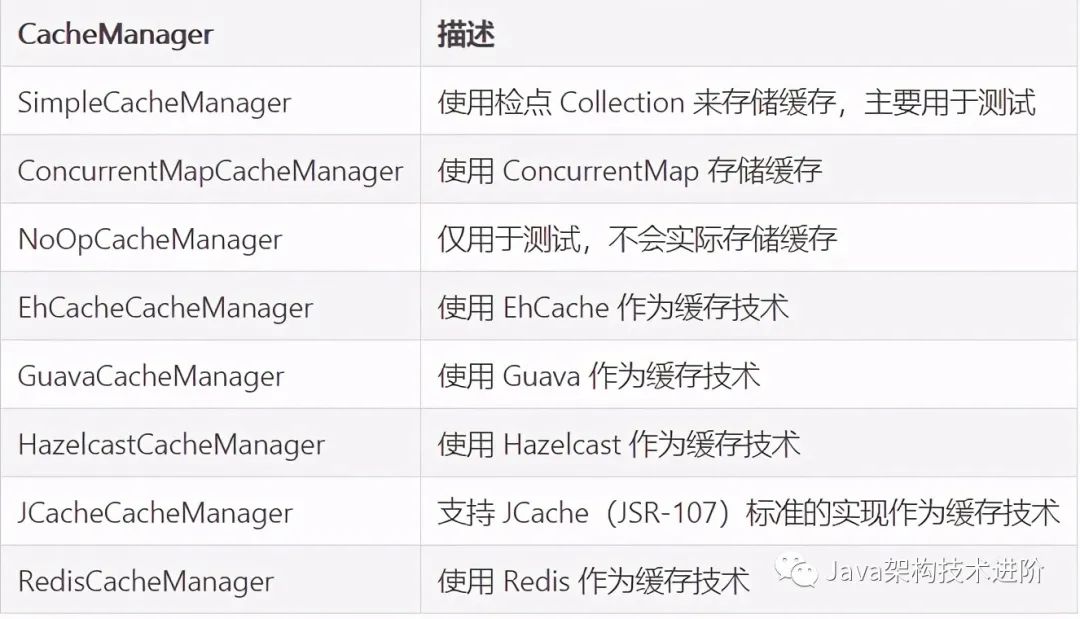SpringBoot实现缓存机制
简介
Spring 定义 CacheManager 和 Cache 接口用来统一不同的缓存技术。例如 JCache、 EhCache、 Hazelcast、 Guava、 Redis 等。在使用 Spring 集成 Cache 的时候,我们需要注册实现的 CacheManager 的 Bean。Spring Boot 默认使用的是 SimpleCacheConfiguration,即使用 ConcurrentMapCacheManager 来实现的缓存。
CacheManager:缓存管理器,管理各种缓存组件

Cache 注解详解
1. @CacheConfig
@CacheConfig:主要用于配置该类中会用到的一些共用的缓存配置。
在这里 @CacheConfig(cacheNames = “users”):配置了该数据访问对象中返回的内容将存储于名为 users 的缓存对象中,我们也可以不使用该注解,直接通过 @Cacheable 自己配置缓存集的名字来定义。
2. @Cacheable
@Cacheable:主要针对方法配置,能够根据方法的请求参数对其结果进行缓存。同时在查询时,会先从缓存中获取,若不存在才再发起对数据库的访问。该注解主要有下面几个参数:
value、cacheNames:两个等同的参数(cacheNames 为Spring 4 新增,作为 value 的别名),用于指定缓存存储的集合名。由于 Spring 4 中新增了 @CacheConfig,因此在 Spring 3 中原本必须有的 value 属性,也成为非必需项了。
key:缓存对象存储在 Map 集合中的 key 值,非必需,缺省按照函数的所有参数组合作为 key 值,若自己配置需使用 SpEL表 达式,比如:@Cacheable(key = “#p0”):使用函数第一个参数作为缓存的 key 值,更多关于 SpEL 表达式的详细内容可参考官方文档。
condition:缓存对象的条件,非必需,也需使用SpEL表达式,只有满足表达式条件的内容才会被缓存,比如:@Cacheable(key = “#p0”, condition = “#p0.length() < 3”),表示只有当第一个参数的长度小于3的时候才会被缓存,若做此配置上面的AAA用户就不会被缓存,读者可自行实验尝试。
unless:另外一个缓存条件参数,非必需,需使用 SpEL 表达式。它不同于 condition 参数的地方在于它的判断时机,该条件是在函数被调用之后才做判断的,所以它可以通过对 result 进行判断。
keyGenerator:用于指定 key 生成器,非必需。若需要指定一个自定义的 key 生成器,我们需要去实现org.springframework.cache.interceptor.KeyGenerator 接口,并使用该参数来指定。需要注意的是,该参数与 key 是互斥的。
cacheManager:用于指定使用哪个缓存管理器,非必需。只有当有多个时才需要使用。
cacheResolver:用于指定使用那个缓存解析器,非必需。需通过
org.springframework.cache.interceptor.CacheResolver 接口来实现自己的缓存解析器,并用该参数指定。
3. @CachePut
@CachePut:配置于方法上,能够根据参数定义条件来进行缓存,它与 @Cacheable 不同的是,它不会去检查缓存中是否存在之前执行过的结果,而是每次都会执行该方法,并将执行结果以键值对的形式存入缓存中,所以主要用于数据新增和修改操作上。它的参数与 @Cacheable 类似,具体功能可参考上面对 @Cacheable 参数的解析。
4. @CacheEvict
@CacheEvict:配置于函数上,通常用在删除方法上,用来从缓存中移除相应数据。除了同 @Cacheable 一样的参数之外,它还有下面两个参数:
allEntries:非必需,默认为 false。当为 true 时,会移除所有数据。
beforeInvocation:非必需,默认为 false,会在调用方法之后移除数据;当为 true 时,会在调用方法之前移除数据。
搭建 Spring Boot 默认缓存
1.开启缓存支持
package org.jeemp.cache;
import org.springframework.boot.SpringApplication;
import org.springframework.boot.autoconfigure.SpringBootApplication;
import org.springframework.cache.annotation.EnableCaching;
@SpringBootApplication
@EnableCaching // 开启缓存功能
public class JeempCacheApplication {
public static void main(String[] args) {
SpringApplication.run(JeempCacheApplication.class, args);
}
}
2.添加缓存依赖
<?xml version="1.0" encoding="UTF-8"?>
<project xmlns="http://maven.apache.org/POM/4.0.0" xmlns:xsi="http://www.w3.org/2001/XMLSchema-instance"
xsi:schemaLocation="http://maven.apache.org/POM/4.0.0 https://maven.apache.org/xsd/maven-4.0.0.xsd">
<modelVersion>4.0.0</modelVersion>
<parent>
<groupId>org.springframework.boot</groupId>
<artifactId>spring-boot-starter-parent</artifactId>
<version>2.4.3</version>
<relativePath/> <!-- lookup parent from repository -->
</parent>
<groupId>org.jeemp</groupId>
<artifactId>jeemp-cache</artifactId>
<version>0.0.1-SNAPSHOT</version>
<name>jeemp-cache</name>
<description>Demo project for Spring Boot</description>
<properties>
<java.version>1.8</java.version>
</properties>
<dependencies>
<dependency>
<groupId>org.springframework.boot</groupId>
<artifactId>spring-boot-starter-web</artifactId>
</dependency>
<dependency>
<groupId>org.springframework.boot</groupId>
<artifactId>spring-boot-starter-cache</artifactId>
</dependency>
<dependency>
<groupId>org.projectlombok</groupId>
<artifactId>lombok</artifactId>
</dependency>
</dependencies>
<build>
<plugins>
<plugin>
<groupId>org.springframework.boot</groupId>
<artifactId>spring-boot-maven-plugin</artifactId>
</plugin>
</plugins>
</build>
</project>
3.模拟数据
package org.jeemp.cache.db;
import org.jeemp.cache.dto.UserDto;
import java.util.ArrayList;
import java.util.List;
/**
* @author JackRen
* @date 2021-03-05 16:41
* @description:
*/
public class DataFactory {
private DataFactory() {
}
private static List<UserDto> userDtoList;
static {
// 初始化集合
userDtoList = new ArrayList<>();
UserDto user = null;
for (int i = 0; i < 10; i++) {
user = new UserDto();
user.setName("jack" + i);
user.setAge("2" + i);
userDtoList.add(user);
}
}
public static List<UserDto> getUserDaoList() {
return userDtoList;
}
}
缓存业务代码
package org.jeemp.cache.service;
import org.jeemp.cache.db.DataFactory;
import org.jeemp.cache.dto.UserDto;
import org.springframework.stereotype.Repository;
import java.util.List;
import java.util.Objects;
/**
* @author JackRen
* @date 2021-03-05 16:46
* @description:
*/
@Repository
public class UserRepository {
/**
* 获取用户信息(此处是模拟的数据)
*/
public UserDto getUser(String username) {
UserDto user = getUserFromList(username);
return user;
}
/**
* 删除用户信息
*/
public List<UserDto> deleteUser(String username) {
List<UserDto> userDaoList = DataFactory.getUserDaoList();
userDaoList.remove(getUserFromList(username));
return userDaoList;
}
/**
* 新增数据
*/
public List<UserDto> save(String username) {
// 添加到集合
List<UserDto> userDaoList = DataFactory.getUserDaoList();
for (UserDto userDto : userDaoList) {
// 不能重复添加相同数据
if (Objects.equals(userDto.getName(), username)) {
return userDaoList;
}
}
UserDto user = new UserDto();
user.setName(username);
user.setAge("50");
userDaoList.add(user);
return userDaoList;
}
/**
* 从模拟的数据集合中筛选 username 的数据
*/
private UserDto getUserFromList(String username) {
List<UserDto> userDaoList = DataFactory.getUserDaoList();
for (UserDto user : userDaoList) {
if (Objects.equals(user.getName(), username)) {
return user;
}
}
return null;
}
}
package org.jeemp.cache.service;
import org.jeemp.cache.dto.UserDto;
import org.springframework.beans.factory.annotation.Autowired;
import org.springframework.cache.annotation.CacheConfig;
import org.springframework.cache.annotation.CacheEvict;
import org.springframework.cache.annotation.CachePut;
import org.springframework.cache.annotation.Cacheable;
import org.springframework.stereotype.Service;
import java.util.List;
/**
* @author JackRen
* @date 2021-03-05 16:46
* @description:
*/
@Service
@CacheConfig(cacheNames = "users")// 指定缓存名称,在本类中是全局的
public class UserService {
@Autowired
private UserRepository userRepository;
/**
* 缓存 key 是 username 的数据到缓存 users 中,
* 如果没有指定 key,则方法参数作为 key 保存到缓存中
*/
@Cacheable(key = "#username")
public UserDto getUser(String username) {
System.out.println("从数据库中获取数据,而不是读取缓存");
return userRepository.getUser(username);
}
/**
* 新增或更新缓存中的数据
*/
@CachePut(key = "#username")
public List<UserDto> save(String username) {
return userRepository.save(username);
}
/**
* 从缓存 users 中删除 key 是 username 的数据
*/
@CacheEvict(key = "#username")
public List<UserDto> deleteUser(String username) {
System.out.println("从数据库中删除数据,以及缓存中的数据");
return userRepository.deleteUser(username);
}
}
接口类
package org.jeemp.cache.rest;
import org.jeemp.cache.dto.UserDto;
import org.jeemp.cache.service.UserService;
import org.springframework.beans.factory.annotation.Autowired;
import org.springframework.http.ResponseEntity;
import org.springframework.web.bind.annotation.*;
import java.util.List;
/**
* @author JackRen
* @date 2021-03-05 16:48
* @description:
*/
@RestController
@RequestMapping("/api")
public class CacheResourceController {
@Autowired
private UserService userService;
@GetMapping("/users/{username}")
public ResponseEntity<UserDto> getUser(@PathVariable String username) {
// 获取数据
UserDto user = userService.getUser(username);
return ResponseEntity.ok(user);
}
@PutMapping("/users/{username}")
public ResponseEntity<List<UserDto>> save(@PathVariable String username) {
List<UserDto> userDtoList = userService.save(username);
return ResponseEntity.ok(userDtoList);
}
@DeleteMapping("/users/{username}")
public ResponseEntity<List<UserDto>> delete(@PathVariable String username) {
List<UserDto> userDtoList = userService.deleteUser(username);
return ResponseEntity.ok(userDtoList);
}
}
测试
启动项目

请求接口:
http://localhost:8080/api/users/jack1

控制台打印:

我们再进行请求,发现日志不再打印,说明数据是从缓存中拿到!
